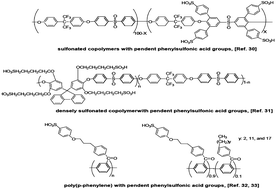This review paper covers recent publications on the developments of highly proton-conductive sulfonated polymers for proton exchange membrane (PEM) fuel cells. The PEMs presenting proton conductivities exceeding that of Nafion membranes are especially focused on. The proton conductivities of PEMs have been correlated to their ion exchange values and morphological phase-separation. Formation of ionic channels is an effective approach to develop highly proton-conductive PEMs. The approaches could be grouped into (1) developments of microphase-separation with block copolymers, (2) side-chain and grafted sulfonated polymers, and (3) locally and densely sulfonated polymers. Formation of nanocomposites of PEMs with nanofillers has also shown great ability to increase the proton conductivities of the existed PEMs. Besides proton conductivities, the formation of nanocomposites also improves some PEM properties including mechanical strength, dimensional stability, and oxidative stability. The discussed publications have provided promising PEMs for the development of high performance fuel cells.
